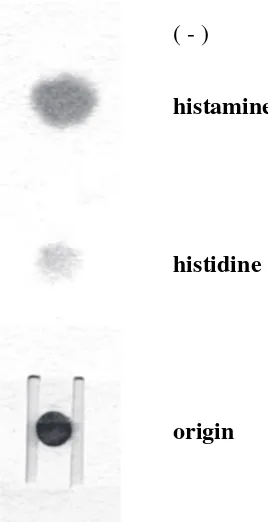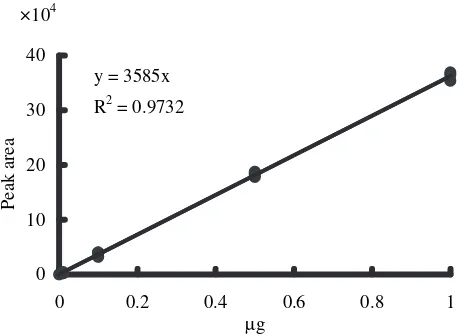FISHERIESSCIENCE2006; 72: 889–892
*Corresponding author: Tel: 81-22-717-8736. Fax: 81-22-717-8739. Email: [email protected]
Received 4 November 2005. Accepted 21 February 2006.
A simple and rapid method for the analysis of fish
histamine by paper electrophoresis
Minoru SATO,1* Zhi Hua TAO,1Kazuhiro SHIOZAKI,1Toshiki NAKANO,1
Toshiyasu YAMAGUCHI,1Takehiko YOKOYAMA,2Nobuhiro KAN-NO2 AND Eizoh NAGAHISA2
1Graduate School of Agricultural Science, Tohoku University, Sendai, Miyagi 981-8555, and 2School of Fisheries Science, Kitasato University, Ofunato, Iwate 022-0101, Japan
ABSTRACT: The described analytical method for histamine determination in fish and seafood
con-sists of sample extraction, adsorption onto a paper disc, application of the paper disc onto electro-phoresis paper, electroelectro-phoresis for only 10 min, drying, and color developing by Pauly’s reagent. Histamine can be satisfactorily detected and completely separated from histidine, carnosine and other Pauly reagent-positive compounds. This method does not require expensive instrumentation and any tedious pretreatment to eliminate potential interference by other imidazole compounds, such as his-tidine or carnosine. This method can be used to detect histamine in multiple fish and seafood samples simultaneously that contain as little as 15 p.p.m. histamine (1.5 mg/100 g).
KEY WORDS: determination, fish, histamine, paper electrophoresis, Pauly reagent.
INTRODUCTION
Histamine is known as a chemically harmful sub-stance that can induce allergy-like food poisoning when ingested fish and seafood.1–3 Therefore, the histamine content in seafood is of great concern in food hygiene.4 In most cases, histamine levels in illness-causing fish have been above 200 p.p.m., often above 500 p.p.m.5 Histamine is contained in various types of fresh and processed fish.6–8 To pre-vent histamine-induced seafood poisoning, the U.S. Food and Drug Administration (FDA) estab-lished a hazards analysis and critical control point program and set up guidelines for histamine at 5 mg/100 g (50 p.p.m) for scombroid fish species.9 Histamine monitoring has now been globally accepted for safety confirmation of fish and sea-food products. A simple and rapid method for his-tamine analysis is now required all over the world. Different determination methods have been used for the quantification of histamine, including a bioassay, thin-layer chromatography, gas chro-matography, gas chromatography/mass spec-trometry, colorimetric assay, fluorometric assay, enzymatic isotopic assay, immunological assay and high-performance liquid chromatography
(HPLC).1 A very serious problem in histamine determination is to separate histamine completely from a very large amount of interfering com-pounds, such as histidine or carnosine. Therefore, a careful and tedious pretreatment is required to eliminate potential interfering substances.10,11
In 1995, Sato et al. reported a simple method based on the one-step derivatization and HPLC separation;12 however, this method required an expensive instrument and skilled operator. A rapid method by paper electrophoresis was also devel-oped.13 However, there are some points to be improved in this analytical method; for example, the spotting procedure of the sample solution on the electrophoresis paper and the spraying proce-dure of the electrophoresis buffer on the elec-trophoresis paper after sample spotting. In this present study, the authors describe a simple and rapid method for fish and seafood histamine anal-ysis by paper electrophoresis and Pauly reagent development which can be possibly used during the postcatching contamination periods, such as in the processing plant, the distribution system, restaurants or the home.
MATERIALS AND METHODS
Materials
890 FISHERIES SCIENCE M Sato et al.
Chemical Industries (Osaka, Japan). Imidazole, 2-and 4-methylimidazole, L-carnosine 2-and urocanic acid (imidazole-4-acrylic acid) were purchased from Sigma-Aldrich (St. Louis, MO, USA), and all other reagents used were of analytical grade. Pauly reagent (A and B) for the development of histamine was prepared by the method of Sato et al.13 Reagent A also consisted of two reagents, A-1 and A-2. Reagent A-1, a 20 mM sulfanilic acid in a 1 M HCl solution and reagent A-2, a 200 mM sodium nitrite solution. Reagents A-1 and A-2 were equally mixed just before spraying. Reagent B, a l0% anhydrous sodium carbonate in a 5% ethanol solution. Paper electrophoresis apparatus (Histamine Checker; JBB, Saitama, Japan) and electrophoresis paper with H-shape hole (30 cm length × 9 cm or 15 cm width) were purchased from JBB (Saitama, Japan).
Preparation of sample extract
Fish flesh sample of approximately 200 mg was homogenized with 5 volume (v/w) of 80% ethanol using a Polytron homogenizer. Each homogenate was centrifuged at 10 000 ×g for 5 min. Ten micro-liters of supernatant (10 µL) was applied to paper disc (6 mm in diameter).
Paper electrophoresis
Paper electrophoresis was conducted using Hista-mine Checker (JBB) during this experiment. The electrophoresis paper was set on the electrophore-sis holder and immersed in the electrophoreelectrophore-sis buffer, consisting of pyridine, acetic acid and water (1 : 10 : 289, pH 3.7). The electrophoresis paper holder was set into the electrophoresis apparatus chamber. Then, the paper disc containing the sam-ple solution was set at the center of the H-shape hole of electrophoresis paper. The electrophoresis was conducted at 800 V for 10 min. The paper was then dried at 100°C using a forced convection oven (FC-410; ADVANTEC, Tokyo, Japan).
Color developing for histamine and quantification
Histamine on the electrophoresis paper was devel-oped by spraying with Pauly reagent A (equal mixture of A-1 and A-2) and then regent B. The developed paper was then set on the light box (FUJICOLOR, Tokyo, Japan) and the color density of histamine spot was recorded using a digital cam-era CP-800 (EPSON, Tokyo, Japan). The histamine spot was digitized and calculated by image
pro-cessing method software, Lane & Spot Analyzer (ATTO, Tokyo, Japan). A standard histamine solu-tion, 9 nmol (1.0 µg)/10 µL, was used as the inter-nal standard.
RESULTS AND DISCUSSION
Separation of histamine, histidine and other Pauly reagent-positive compounds
Histamine gave a red spot after Pauly reagent development and was completely separated from histidine (Fig. 1). It has been confirmed that hista-mine was also perfectly separated from other Pauly reagent positive compounds, such as imidazole, 2-and 4-methylimidazole, L-carnosine 2-and urocanic acid, by 10 min electrophoresis, as mentioned in a previous report.13
Linearity of histamine determination
The linearity of the histamine estimation using this imaging processing method was good within the range from 30 to 1000 ng (1 µg) of histamine (Fig. 2).
Fig. 1 Typical electrophoresis pattern of standard his-tamine and histidine on the electrophoresis paper with H-shape hole.
( - )
histamine
histidine
Method comparison
The histamine levels in mackerel flesh with skin incubated at 25°C were compared using this elec-trophoresis method and the HPLC method.12 The histamine contents in the mackerel flesh samples determined by the two methods were highly com-parable in samples taken at all incubation times (Table 1).
Overall estimation
The improved method for histamine analysis by electrophoresis separation and Pauly reagent is more straight-forward and quicker than the method reported previously.13 It eliminates the somehow nervous and awkward steps, such as the spotting procedure of the sample solution on the electrophoresis paper and the careful spray procedure of the electrophoresis buffer on the electrophoresis paper upon which the sample solution had been previously spotted. Most importantly, the procedure can be conducted by individuals with minimal technical skills.
Although this method is less sensitive than the HPLC method, it can simultaneously determine
multiple samples in less than 30 min. It is notewor-thy that the entire estimation time of one sample is quite short compared with the HPLC and other previously reported methods. The detection limit for histamine was 15 p.p.m. (1.5 mg/100 g), which is more sensitive than the guidance level of 50 p.p.m. set by the FDA.9 It is well known that his-tamine is generally not uniformly distributed in decomposed fish. If 50 p.p.m. is found in one sec-tion, there is the possibility that other sections may exceed 500 p.p.m.9 It is advisable to check several sections simultaneously. This new method can be therefore used in various contexts, such as in the fish market, processing plant, distribution center or restaurants.
ACKNOWLEDGMENTS
This work was partly supported by a Grant-in-Aid for Science Research (B) (No. 09556045) from the Ministry of Education, Science, Sports, and Culture of Japan.
REFERENCES
1. Sato M. Fish inspection freshness assessment. In: Jensen W, Devine C, Dikemann M (eds). Encyclopedia of Meat Science. Elsevier, Oxford, 2004; 474–482.
2. Ushiyama H, Kan K, Shindo T, Saito K. Outbreaks of food poisoning by chemical and naturally occurring toxicants in Tokyo – 2002. Ann. Rep. Tokyo Metr. Inst. P.H. 2003; 54: 214– 219.
3. Lehane L, Olley J. Histamine fish poisoning revisited. Int. J.
Food Microb. 2000; 58: 1–37.
4. Kan K, Ushiyama H, Shindo T, Saito K. Survey of histamine content in seafood on the market. J. Food Hygien. Sci. Jpn. 2005; 46: 127–132.
5. Food and Drug Administration (FDA). Scombrotoxin (hista-mine) formation. Fish and Fishery Products Hazards and
Controls Guide, 2nd edn. Department of health and human
services, Public health service, Food and Drug Administra-tion, Center for Food Safety and Applied NutriAdministra-tion, Office of Seafood, Washington, DC. 1998; 91–92.
6. Kawabata T, Ishizaka K, Miura T. Studies on the allergy-like food poisoning associated with putrefaction of marine Table 1 Comparison of the histamine contents obtained by paper electrophoresis and high-performance liquid chro-matography method
Incubation time (h) (p.p.m.)†
0 3 6 24 36
Electrophoresis method ND‡ 32
± 4 113 ± 7 2150 ± 20 4503 ± 38
HPLC method ND 38 ± 2 120 ± 5 2006 ± 8 4480 ± 19
†Mackerel flesh with skin was incubated at 25°C; ‡not detected. §data are shown mean ± standard deviation by three determinations.
HPLC, high-performance liquid chromatography.
Fig. 2 Calibration curve of histamine.
892 FISHERIES SCIENCE M Sato et al.
products. II. Separation of causative substance and some of its chemical characteristics. Jpn. J. Med. Sci. Biol. 1955; 8: 503–519.
7. Kanmuri M, Kan K, Hashimoto H, Maki T, Tamura Y. Out-breaks of food poisoning of chemical and naturally occur-ring toxicants in Tokyo – 1996. Ann. Rep. Tokyo Metr. Res. Lab. 1997; 45: 111–115.
8. Lipp EK, Rose JB. The role of seafood in foodborne diseases in the United States of America. Rev. Sci. Technol. 1997; 16: 620–640.
9. Food and Drug Administration (FDA). FDA and EPA guid-ance levels. Fish and Fishery Products Hazards and Controls
Guide, 2nd edn. Department of Health and Human Services,
Public Health Service, Food and Drug Administration, Cen-ter for Food Safety and Applied Nutrition, Office of Seafood, Washington, DC. 1998; 245–248.
10. Kawabata T, Uchida Y, Akano T. A simple and rapid method for the determination of histamine in fish flesh. Nippon
Suisan Gakkaishi 1960; 26: 1183–1191.
11. Taylor SL, Lieber ER, Leatherwood M. A simplified method for histamine analysis of foods. J. Food Sci. 1978; 43: 247– 250.
12. Sato M, Nakano T, Takeuchi M, Kumagai T, Kanno N, Nagahisa E, Sato Y. Specific determination of histamine in fish by high-performance liquid chromatography after diazo coupling. Biosci. Biotech. Biochem. 1995; 59: 1208– 1210.
13. Sato M, Tao ZH, Shiozaki K, Nakano T, Yamaguchi T, Kum-agai T, Yokoyama T, Kan-no N, Nagahisa E. A rapid method for histamine analysis of seafoods by paper electrophoresis.

